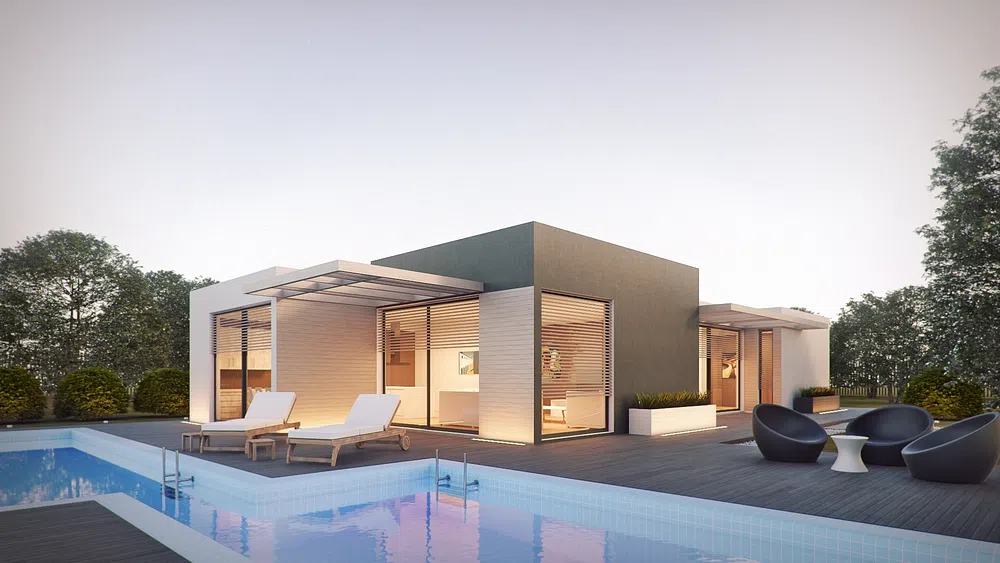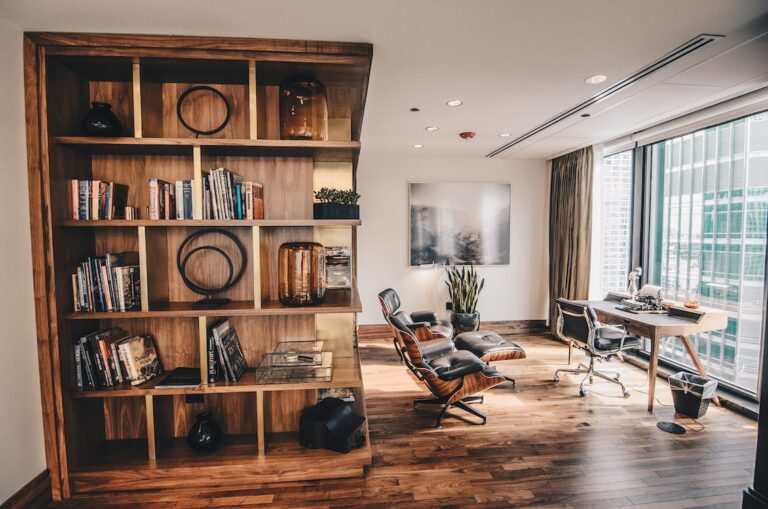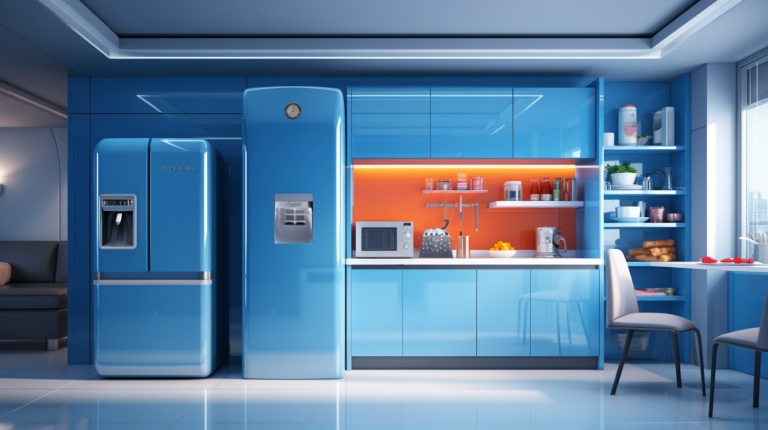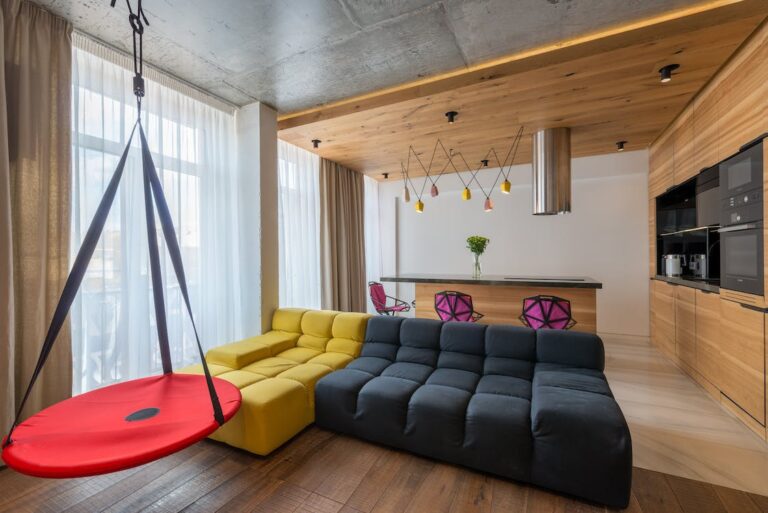Elevate Your Home’s Architecture with Sustainable Design Elements in 2023
Hey there, friend! Are you looking to make your home not only visually stunning but also environmentally friendly? Well, you’ve come to the right place! In this article, we’re going to explore the world of sustainable design and discover how you can elevate your home’s architecture with eco-friendly elements.
Sustainable design is all about creating spaces that are not only beautiful but also minimize their impact on the environment. By incorporating sustainable design elements into your home, you can enjoy a variety of benefits, including reduced energy consumption, lower water usage, and improved indoor air quality. So let’s dive in and explore the key principles of sustainable design, as well as the many ways you can incorporate these elements into your home. Get ready to transform your living space into an eco-friendly haven that you can be proud of!
Now that we have piqued your interest, let’s take a closer look at what sustainable design is all about.
Table of Contents
Understanding Sustainable Design

Key Principles of Sustainable Design
Sustainable design is an approach to architecture that prioritizes environmental responsibility and resource efficiency. It is a design philosophy that aims to minimize the negative impact of buildings on the environment while enhancing the health and well-being of occupants. Here are some key principles of sustainable design:
- Energy Efficiency: Designing buildings to reduce energy consumption is a fundamental principle of sustainable design. This involves utilizing passive solar design strategies, proper insulation, and energy-efficient appliances and lighting.
- Water Conservation: Sustainable design incorporates strategies to conserve water, such as the use of low-flow fixtures, rainwater harvesting systems, and drought-tolerant landscaping.
- Waste Management: Minimizing waste is another crucial aspect of sustainable design. This includes reducing, reusing, and recycling materials, implementing composting systems, and minimizing construction waste.
- Healthy Indoor Environment: Sustainable design prioritizes the health and well-being of occupants by using non-toxic materials, ensuring good ventilation, and incorporating biophilic design elements that connect people with nature.
- Enhancing Natural Light and Ventilation: Sustainable design emphasizes the use of natural light and ventilation to reduce the need for artificial lighting and HVAC systems. This can be achieved through strategic window placement, skylights, solar tubes, and efficient ventilation systems.
- Incorporating Sustainable Materials: Using sustainable materials like bamboo and cork flooring, recycled or reclaimed materials, and low VOC (volatile organic compounds) paints and finishes is integral to sustainable design.
- Smart Home Technology: Smart home technology plays a vital role in sustainable design by enabling energy monitoring and management, automated lighting and climate control, and smart appliances and water systems.
- Landscaping and Outdoor Design: Sustainable design extends to outdoor spaces, emphasizing the incorporation of native plants, permeable surfaces to minimize stormwater runoff, and green roofs and living walls to reduce heat island effect and improve air quality.
Benefits of Incorporating Sustainable Design Elements
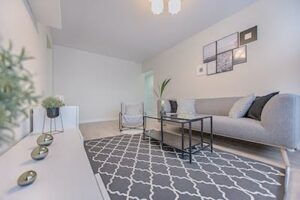
Incorporating sustainable design elements into your home’s architecture offers a range of benefits, not just for the environment but also for you as a homeowner. Here are some advantages of sustainable design:
- Energy and Cost Savings: By maximizing energy efficiency, sustainable design can significantly reduce your energy consumption and utility bills. With proper insulation, energy-efficient appliances, and smart home technology, you can save money while reducing your carbon footprint.
- Improved Indoor Air Quality: Using non-toxic materials and ensuring adequate ventilation leads to better indoor air quality, promoting the health and well-being of you and your family. This is especially important for individuals with allergies or respiratory conditions.
- Reduced Water Consumption: With water conservation strategies like low-flow fixtures and rainwater harvesting, sustainable design helps reduce water consumption. This not only benefits the environment but can also result in lower water bills.
- Enhanced Comfort and Well-being: Incorporating sustainable design elements such as natural light, proper ventilation, and biophilic design creates a comfortable and healthy living environment. Natural light can boost mood and productivity, while good ventilation promotes fresh air circulation.
- Preservation of Natural Resources: By using sustainable materials and minimizing waste, sustainable design helps preserve natural resources and reduces the demand for virgin materials. This contributes to the conservation of ecosystems and wildlife habitats.
- Increased Property Value: Homes with sustainable design elements are in high demand due to their energy efficiency and environmental benefits. Therefore, incorporating sustainable design into your home can potentially increase its resale value.
Incorporating sustainable design elements into your home not only helps protect the environment but also provides tangible benefits for you as a homeowner. From energy and cost savings to improved indoor air quality and increased property value, embracing sustainable design is a win-win situation for both you and the planet.
Energy Efficiency

When it comes to sustainable home design, energy efficiency plays a crucial role. Not only does it help reduce your carbon footprint and conserve natural resources, but it can also lead to significant cost savings on your energy bills. Here are a few key ways to incorporate energy efficiency into your home design:
Passive Solar Design
Passive solar design is all about harnessing the power of the sun to heat and cool your home naturally. By strategically positioning windows, insulation, and shading elements, you can maximize the use of solar energy for heating during the winter and minimize it during the summer. Some tips for passive solar design include:
- Window Placement: Orienting windows to face south or north, depending on your location, can optimize solar gain and minimize heat loss.
- Insulation: Make sure your home is well-insulated, especially in areas like walls, floors, and roofs, to prevent heat transfer and maintain a comfortable indoor temperature.
- Shading: Consider adding overhangs, awnings, or external shading devices to control the amount of sunlight entering your home and reduce the need for mechanical cooling.
Proper Insulation and Weatherization
Insulation is the key to keeping your home comfortable and energy-efficient. By insulating your walls, floors, and roofs, you can minimize heat loss in the winter and heat gain in the summer. Proper weatherization techniques, such as sealing air leaks and adding weatherstripping around doors and windows, can also help prevent drafts and improve energy efficiency.
Energy-Efficient Appliances and Lighting
Another way to boost your home’s energy efficiency is by choosing appliances and lighting fixtures that are energy-efficient. Look for appliances with the Energy Star label, as they meet strict energy efficiency guidelines set by the Environmental Protection Agency (EPA). Additionally, LED bulbs are a great choice for lighting, as they consume less energy and last longer compared to traditional incandescent bulbs.
By incorporating these energy-efficient design elements into your home, you can enjoy enhanced comfort, reduced energy consumption, and lower utility bills. It’s a win-win for both the environment and your wallet!
Water Conservation

Water conservation is an important aspect of sustainable design that should not be overlooked. Implementing water-saving measures in your home can not only help protect this precious resource, but also reduce your water bills. Here are some key ways to conserve water in your home:
Low-Flow Fixtures
One of the easiest ways to conserve water is by installing low-flow fixtures in your home. These fixtures, such as low-flow toilets, faucets, and showerheads, are designed to reduce water usage without sacrificing performance. By replacing your old fixtures with low-flow options, you can significantly reduce your water consumption.
Rainwater Harvesting
Rainwater harvesting involves collecting rainwater and storing it for later use. This can be done by installing a rainwater harvesting system, which typically consists of gutters, downspouts, and storage tanks. The collected rainwater can be used for watering plants, flushing toilets, and even for laundry purposes. It not only reduces your reliance on municipal water supply, but also helps prevent stormwater runoff, which can contribute to water pollution.
Drought-Tolerant Landscaping
One of the biggest sources of water consumption is outdoor landscaping. However, you can still have a beautiful and thriving garden while conserving water. Choose native plants and grasses that are well-suited to your region’s climate and require less water. Additionally, consider incorporating drought-tolerant landscaping techniques such as xeriscaping, which involves using plants that don’t require much water and implementing efficient irrigation systems.
Benefit of Water Conservation
- Helps preserve water resources for future generations.
- Reduces strain on municipal water supplies.
- Lowers water bills and saves money.
- Prevents water pollution by minimizing stormwater runoff.
- Promotes healthier and more sustainable gardens and landscapes.
Incorporating water conservation measures in your home not only benefits the environment, but also has financial advantages. By reducing your water consumption, you can lower your water bills and save money in the long run. Additionally, by conserving water, you are taking an active role in preserving this vital resource for future generations.
Remember, every drop counts! By implementing water-saving measures in your home, you can make a positive impact on the environment while enjoying the benefits of a more sustainable and cost-effective lifestyle.
Waste Management

When it comes to sustainable design, waste management plays a crucial role in minimizing the environmental impact of our homes. By implementing effective waste management strategies, we can contribute to reducing waste, conserving resources, and creating a healthier environment. Here are some key aspects of waste management that you can incorporate into your home’s design:
Reduce, Reuse, and Recycle
- One of the fundamental principles of waste management is the “3 R’s”: Reduce, Reuse, and Recycle.
- Reduce: Start by limiting the amount of waste produced in your home. Consider purchasing items with minimal packaging and opt for reusable products instead of disposable ones.
- Reuse: Before throwing something away, think about how it could be repurposed. Get creative with DIY projects or consider donating unwanted items to local charities or thrift stores.
- Recycle: Set up a recycling system in your home to ensure that recyclable materials are properly sorted and sent for recycling. Check with your local municipality to determine what can be recycled in your area.
Composting
- Composting is an excellent way to manage organic waste and create nutrient-rich soil for your garden.
- Collect kitchen scraps like fruit and vegetable peels, coffee grounds, and eggshells in a compost bin or pile.
- Also, add yard waste such as leaves, grass clippings, and small branches.
- Regularly turn the compost to promote decomposition and airflow.
- Within a few months to a year, you’ll have rich compost that can be used to nourish your plants and reduce the need for chemical fertilizers.
Minimizing Construction Waste
- During the construction or renovation process, a significant amount of waste is generated. Minimizing construction waste is an essential step towards sustainable design.
- Plan your project carefully to avoid excess materials and wastage.
- Opt for prefabricated or modular construction methods that generate less waste.
- Recycle or repurpose leftover materials whenever possible.
- Consider working with a contractor who prioritizes waste reduction and recycling.
By implementing these waste management strategies, you can contribute to the overall sustainability of your home. Not only will you reduce your environmental footprint, but you will also save money in the long run by minimizing waste and maximizing resource efficiency. So, let’s be mindful of the waste we produce and take steps to manage it responsibly. Together, we can create a more sustainable future for our homes and the planet.
Healthy Indoor Environment

Creating a healthy indoor environment is crucial for the overall well-being and comfort of your home. By incorporating sustainable design elements, you can improve air quality, reduce toxins, and promote a healthier lifestyle for you and your family. Here are some key aspects to consider when it comes to creating a healthy indoor environment:
Using Non-Toxic Materials
- Opt for paints, adhesives, and finishes that have low or zero volatile organic compounds (VOCs). VOCs are harmful chemicals that can off-gas and contribute to poor indoor air quality.
- Choose furniture, carpets, and flooring made from natural materials like sustainably harvested wood, bamboo, or cork. These materials are often hypoallergenic and free from harmful chemicals.
Good Ventilation
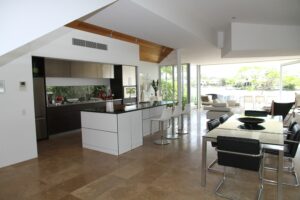
- Proper ventilation is essential for maintaining good indoor air quality. It helps to remove pollutants, allergens, and excess moisture from your home.
- Install exhaust fans in kitchens and bathrooms to remove odors and moisture.
- Consider using a whole-house ventilation system that brings in fresh air and expels stale air to ensure a constant supply of clean indoor air.
Incorporating Biophilic Design
- Biophilic design aims to connect people with nature through the use of natural elements and materials.
- Introduce plants into your indoor spaces to improve air quality and create a sense of calm and well-being.
- Incorporate natural materials like stone, wood, or water features to create a soothing and relaxing environment.
Creating a healthy indoor environment is not only beneficial for your well-being but also contributes to the overall sustainability of your home. By choosing non-toxic materials, ensuring good ventilation, and incorporating biophilic design, you can promote a healthier and more comfortable living space for you and your family. Remember, a healthy home is a happy home!
Enhancing Natural Light and Ventilation

When it comes to creating a sustainable and comfortable living environment, enhancing natural light and ventilation in your home is essential. Not only does it contribute to energy efficiency, but it also improves the overall well-being of the occupants. In this section, we will explore some effective ways to bring in more natural light and fresh air into your home.
Strategic Window Placement
Windows play a key role in allowing natural light to enter your home. By strategically placing windows in areas that receive the most sunlight, you can maximize the amount of daylight that fills your space. Consider the following tips:
- Orientation: Determine which side of your home receives the most sunlight throughout the day and install windows accordingly. South-facing windows typically receive the most sunlight, while north-facing windows receive indirect light.
- Size and Placement: Opt for larger windows to allow more light to enter. Consider installing windows at eye level or higher to maximize light penetration while maintaining privacy.
- Window Treatments: Choose window treatments that allow for easy adjustment of light levels, such as blinds or curtains that can be opened and closed throughout the day.
Skylights and Solar Tubes
If strategic window placement alone doesn’t provide sufficient natural light, you can incorporate skylights and solar tubes into your home design. These elements allow light to enter from above, providing a more diffused and even distribution of light. Consider the following options:
- Skylights: Skylights are windows installed in the roof of a house. They can be fixed or operable, allowing for ventilation in addition to natural light.
- Solar Tubes: Solar tubes are tubular skylights that capture sunlight from the roof and channel it into a room through a reflective tube. They are a great option for spaces where traditional skylights may not be feasible.
Ventilation Systems
In addition to maximizing natural light, ensuring proper ventilation in your home is crucial for maintaining a healthy and comfortable indoor environment. Effective ventilation helps remove moisture, odors, and airborne pollutants, improving indoor air quality. Consider the following ventilation options:
- Natural Ventilation: Take advantage of cross ventilation by strategically placing windows and openings on opposite sides of a room or house to allow for the natural flow of air.
- Mechanical Ventilation: Install mechanical ventilation systems, such as exhaust fans and whole-house ventilation systems, to actively remove stale air and introduce fresh air into your home.
- Energy Recovery Ventilation (ERV): ERV systems are designed to recover and transfer heat or coolness from outgoing stale air to incoming fresh air, helping to maintain a comfortable temperature while providing fresh airflow.
Enhancing natural light and ventilation in your home not only reduces the need for artificial lighting and air conditioning but also creates a brighter and more inviting space for you and your family to enjoy. Incorporating these elements will not only contribute to the sustainable design of your home but also improve your overall quality of life.
So, let the sunshine in and breathe in the fresh air, all while reducing your carbon footprint and creating a more sustainable living environment!
Incorporating Sustainable Materials

When it comes to sustainable design for your home, one of the most important aspects to consider is the use of sustainable materials. Incorporating sustainable materials into your home not only reduces its environmental impact but also creates a healthier and more energy-efficient living space. Here are some key types of sustainable materials that you can use in your home:
Bamboo and Cork Flooring
- Bamboo is a fast-growing renewable resource that can be harvested within a span of 3-5 years, making it an excellent alternative to traditional hardwood floors.
- Cork is another sustainable flooring option that comes from the bark of cork oak trees. The bark can be harvested without harming the tree, making it a renewable and eco-friendly choice.
- Both bamboo and cork flooring are durable, long-lasting, and provide a unique and natural look to your home.
Recycled or Reclaimed Materials
- Using recycled or reclaimed materials in your home not only reduces waste but also gives new life to materials that would have otherwise ended up in landfills.
- Recycled glass, for example, can be used for countertops or tiles, while reclaimed wood can be repurposed for furniture or flooring.
- Incorporating these materials adds character and a sense of history to your home, while also promoting sustainability.
Low VOC Paints and Finishes
- Volatile Organic Compounds (VOCs) are chemicals found in many paints and finishes that can emit harmful gases into the air, contributing to indoor air pollution and health issues.
- Opting for low VOC paints and finishes reduces your exposure to these harmful chemicals and creates a healthier indoor environment.
- Low VOC paints are now widely available and come in a variety of colors, allowing you to create the desired aesthetic for your home while being environmentally conscious.
By incorporating sustainable materials into your home, you not only contribute to a greener future but also create a warm and inviting space that aligns with your values. These materials are not only eco-friendly but also durable and aesthetically appealing, making them a win-win choice for your home design.
“Incorporating sustainable materials into your home not only reduces its environmental impact but also creates a healthier and more energy-efficient living space.”
Smart Home Technology

Smart home technology is a rapidly growing field that is revolutionizing the way we live. By integrating advanced technology into our homes, we can now control and automate various aspects of our living environment, making it more convenient, efficient, and sustainable. Here are some ways in which smart home technology can elevate your home’s architecture and enhance sustainability:
Energy Monitoring and Management
With smart home technology, you can monitor and manage your energy consumption in real-time. By using smart energy monitors, you can track energy usage throughout your home and identify areas where you can make energy-saving improvements. Smart home systems can also provide suggestions and automate energy-saving routines, such as adjusting the temperature when you’re away from home or turning off lights and appliances when they’re not in use.
Automated Lighting and Climate Control

Smart lighting systems allow you to control and automate your home’s lighting based on various factors, such as occupancy, time of day, and natural light levels. With programmable schedules and motion sensors, you can ensure that lights are only on when needed, reducing energy waste. Similarly, smart thermostats enable you to easily control and optimize your home’s temperature, saving energy and money by adjusting settings according to your preferences and occupancy patterns.
Smart Appliances and Water Systems
By incorporating smart appliances into your home, you can further enhance energy efficiency and sustainability. Smart refrigerators, washing machines, dishwashers, and other appliances can adjust their settings based on usage patterns and energy demand, optimizing performance and reducing energy consumption. Additionally, smart water systems can monitor and control water usage, helping you conserve water and reduce waste.
By integrating these smart home technologies into your home, you can create a more sustainable living environment and reduce your carbon footprint. The benefits of incorporating smart home technology include:
- Energy efficiency: By automating and optimizing the use of energy, smart home technology can help you reduce energy consumption and lower utility bills.
- Convenience: The ability to control and monitor your home’s systems and appliances remotely provides convenience and flexibility in managing your household.
- Cost savings: Smart home technology allows you to identify and eliminate energy waste, saving you money in the long run.
- Environmental impact: With reduced energy consumption and efficient resource management, you are contributing to a more sustainable future.
Embracing smart home technology can elevate your home’s architecture by seamlessly integrating advanced technology and sustainable practices. It not only adds convenience and efficiency to your daily life but also helps protect the environment for future generations.
“Smart home technology allows you to take control of your energy consumption and make sustainable choices effortlessly.”
Landscaping and Outdoor Design

When it comes to sustainable home design, don’t forget about the importance of your landscaping and outdoor design. The way you design and care for your outdoor spaces can have a big impact on the overall sustainability of your home. Here are some tips and ideas to help you elevate your home’s architecture with sustainable landscaping and outdoor design elements.
Native Plants
Choosing native plants for your landscaping is a great way to promote sustainability. Native plants are well adapted to the local climate and require less water, fertilizer, and maintenance compared to non-native species. They also provide habitat for local wildlife and can help improve biodiversity in your area. So do a little research and select plants that are native to your region for your outdoor space.
Permeable Surfaces
Instead of traditional concrete or asphalt surfaces, consider using permeable materials for your driveways, walkways, and patios. Permeable surfaces allow rainwater to penetrate the ground, preventing runoff and reducing the strain on stormwater systems. These surfaces can be made from materials like permeable concrete, gravel, or natural pavers.
Green Roofs and Living Walls
Green roofs and living walls are becoming increasingly popular in sustainable design. Green roofs involve covering a portion or the entire roof with vegetation, providing insulation, reducing stormwater runoff, and improving air quality. Living walls are vertical gardens that can be attached to walls or freestanding structures, adding beauty and reducing heat gain in your outdoor space.
By incorporating these sustainable landscaping and outdoor design elements, you can not only elevate the architecture of your home but also contribute to a healthier and more sustainable environment. Remember, small changes can make a big difference, and it’s never too late to start making your outdoor spaces more eco-friendly.
“Sustainable development is the pathway to the future we want for all. It offers a framework to generate economic growth, achieve social justice, exercise environmental stewardship and strengthen governance.” – Ban Ki-moon
Also read; Unlocking Your Home’s Potential: Tips for Designing the Perfect Space in 2023
Conclusion
In conclusion, incorporating sustainable design elements into your home’s architecture not only benefits the environment but also enhances your overall living experience. By prioritizing energy efficiency, water conservation, waste management, healthy indoor environments, natural light and ventilation, sustainable materials, smart home technology, and landscaping and outdoor design, you can create a home that is both aesthetically pleasing and environmentally responsible.
By implementing the key principles of sustainable design, such as reducing energy consumption, conserving water, minimizing waste, and promoting a healthy indoor environment, you can significantly reduce your carbon footprint and contribute to a more sustainable future. Not only will you be saving money on utilities, but you’ll also be improving the comfort and well-being of your household.
Consider incorporating passive solar design strategies, proper insulation, energy-efficient appliances and lighting, low-flow fixtures, rainwater harvesting systems, and drought-tolerant landscaping. Additionally, opt for non-toxic materials, ensure good ventilation, and embrace biophilic design principles to create a healthy indoor environment.
Harness the power of natural light and ventilation by strategically placing windows, installing skylights and solar tubes, and utilizing ventilation systems to bring fresh air into your living spaces. When it comes to materials, choose eco-friendly options like bamboo and cork flooring, recycled or reclaimed materials, and low VOC paints and finishes.
Embrace smart home technology to monitor and manage your energy usage, automate lighting and climate control, and optimize your appliances and water systems for increased efficiency. Lastly, transform your outdoor spaces with native plants, permeable surfaces, and green roofs and living walls to create a harmonious and sustainable connection between your home and the environment.
By implementing these sustainable design elements, you are not only enhancing the aesthetics and value of your home, but you are also making a positive impact on the planet. Start small and gradually incorporate these elements into your home to create a more sustainable and environmentally-friendly living space for you and your family.
Remember, sustainable design is a journey, and every small step you take towards a greener home makes a significant difference. So, elevate your home’s architecture with sustainable design and join the movement towards a more sustainable future. Your home can be a reflection of your commitment to the environment and a catalyst for positive change.
Frequently Asked Questions
- What are some sustainable design elements for home architecture?Some sustainable design elements for home architecture include passive solar design, green roofs, rainwater harvesting systems, energy-efficient insulation, and the use of eco-friendly materials such as bamboo flooring and recycled glass countertops.
- How can sustainable design elements benefit my home?Sustainable design elements can benefit your home in various ways. They can help reduce energy consumption, lower utility bills, improve indoor air quality, minimize environmental impact, increase property value, and create a healthier living space.
- Do sustainable design elements require a significant investment?While some sustainable design elements may require an initial investment, they can result in long-term cost savings and environmental benefits. Additionally, there are many affordable and budget-friendly options available for incorporating sustainable design into your home.
- Can I retrofit my existing home with sustainable design elements?Yes, it is possible to retrofit your existing home with sustainable design elements. A professional architect or designer can help assess your home’s potential for incorporating sustainable features and recommend suitable improvements based on your specific needs and budget.
- Are there any government incentives or programs for implementing sustainable design elements?Yes, many governments offer incentives, tax credits, and grants to homeowners who incorporate sustainable design elements into their homes. Research local government programs or consult with professionals to understand the available incentives in your area.

